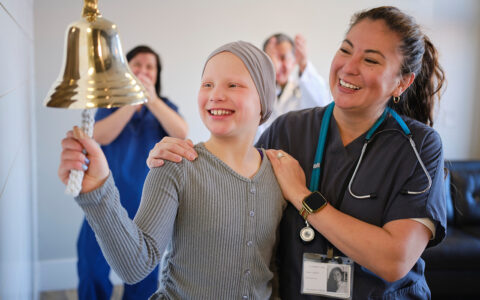Babies born with a single working ventricle are rare, with only five appearing in every 100,000 births. Yet, centers with specialized congenital heart disease programs may see scores of such patients each year.
After the initial surgery, teaching families to monitor and properly care for these babies at home is a clear and present need.
At Monroe Carell Jr. Children’s Hospital at Vanderbilt, a new program helps assure that the 40 or more babies born with single ventricle physiology they treat each year are given the highest possible odds of survival during the critical interstage weeks. This period follows the four to six weeks of hospitalization after stage I palliation, and precedes the next procedure, which is four to six months later.
Cardiologist Jamie Colombo, D.O., co-director of the Single Ventricle Program at Monroe Carell, leads the home monitoring program for these families. Colombo said her team is working to provide quality care for all patients and families by employing multidisciplinary collaboration and one-on-one provider support. A key part of this care oversight is ensuring that parents diligently monitor and report on their babies’ vitals and clinical symptoms, which is key to lowering mortality in the interstage weeks when they are most fragile.
Redirecting Errant Blood Flow
Hypoplastic left heart syndrome, in which babies are born with an underdeveloped, poorly functioning left ventricle, is among the most common single ventricle defects.
In utero and before surgery, these babies have a cardiovascular system that intermingles oxygenated and deoxygenated blood. As a result, the “mixed blood” sent to the body results in low saturation levels. The three-stage palliation, starting with the Norwood procedure, aims to separate the oxygenated and deoxygenated blood.
Starting with the Norwood procedure in the first few weeks of the baby’s life, the surgeon creates a larger aorta by adapting the native pulmonary artery and placing a shunt to pump blood to the lungs as well as the body. By the age of four to six months, the second palliation stage involves a bidirectional Glenn procedure to replace the shunt by connecting the superior vena cava to the pulmonary artery.
The Fontan procedure, typically performed at 3-5 years of age, is stage III palliation, at which point the inferior vena cava is attached to the pulmonary artery, sending the majority of the body’s deoxygenated blood to the lungs.
Risks and Remedies
Of the three procedures, the Norwood is the riskiest, since it involves the most dramatic reconfiguration of the heart in a small, tenuous infant, Colombo said.
“This is where the monitoring comes in,” Colombo explains. “Between stages I and II, the infant remains dependent on a shunt for pulmonary blood flow. It’s important that families at home look for signs that the child may be decompensating and watch for red flag warning signs, such as worsening cyanosis, poor weight gain or fevers, which should prompt medical attention.”
The home monitoring program at Vanderbilt has several features that enable the primary cardiologist, nurse and nurse practitioner to keep virtual eyes on the baby throughout those first precarious weeks.
It starts with counseling for the parents on their own emotional health, as well as teaching them how to care for the baby. On a platform called LOCUS, parents report on the baby’s oxygen saturation levels, heart rate, weight, how much nutrition they take in, how many wet diapers and stools per day, whether they are vomiting, and more.
“On our end, we look for trends that indicate clinical deterioration, which may include shunt occlusion, heart failure or infection,” Colombo said.
The team checks in with the family once or twice weekly by phone and ensures that families have direct phone access to the team. They personally contact primary care physicians and pediatricians to help them know what to look for and whom to consult as babies come in for their routine office visits or due to illness.
Steps Toward Protecting Children’s Future
The home monitoring team has recently expanded to include two clinical psychologists. Plans are to form a multidisciplinary clinic for children with congenital heart disease.
While some patients thrive and recover to the point of becoming varsity athletes, Colombo says others are plagued by cognitive and neural developmental delays, ranging from ADHD or other subtle learning difficulties to significant cognitive dysfunction.
“We know that that a hypoxic environment leads to decreased white matter formation of the brain,” Colombo said. “These children are also subjected to cardiopulmonary bypass early on in life, spending a considerable amount of time sedated and intubated, and they’re at risk for stroke. Early developmental screening and education may help mitigate risk for some of these problems that can affect them later in life.”






